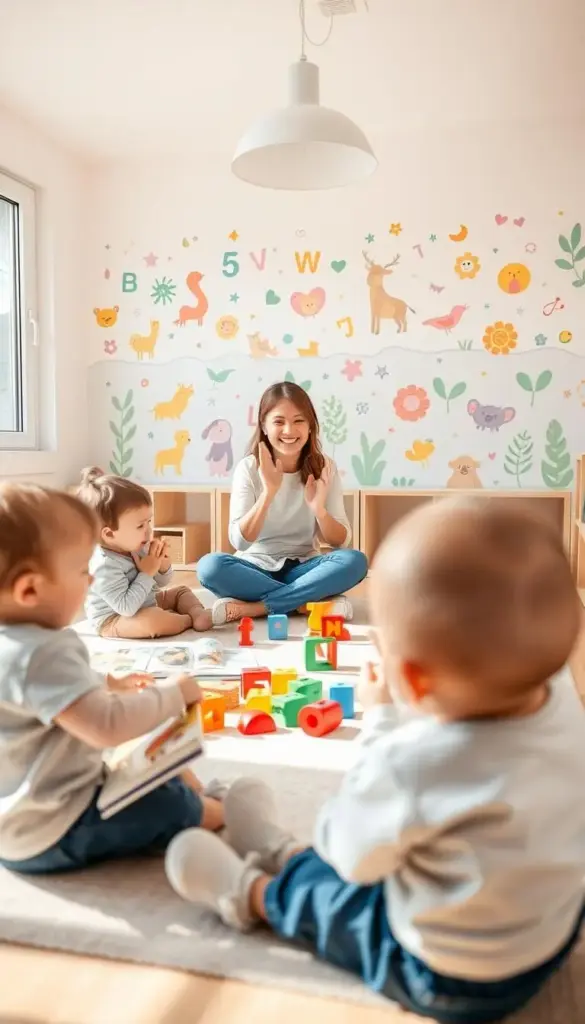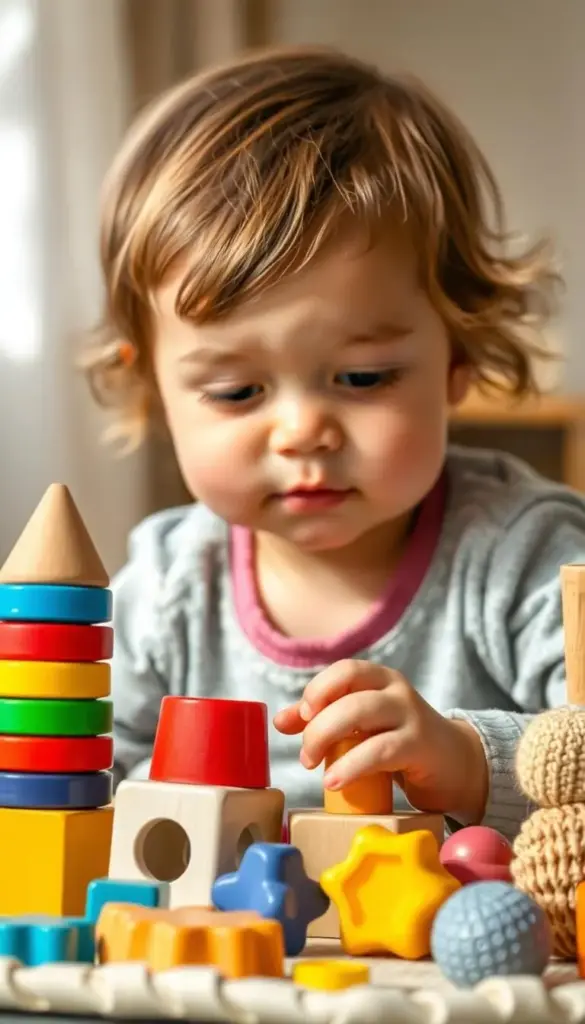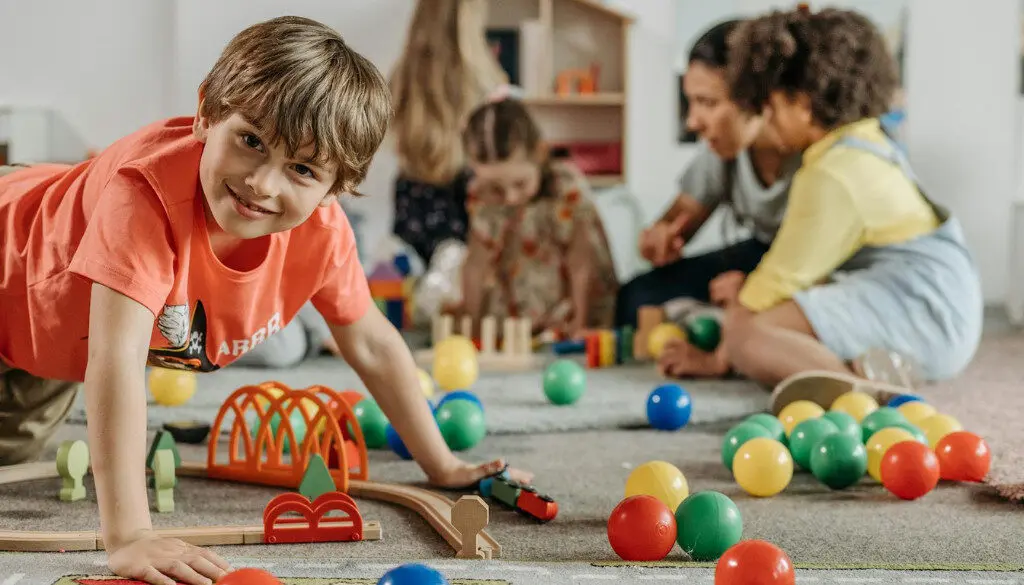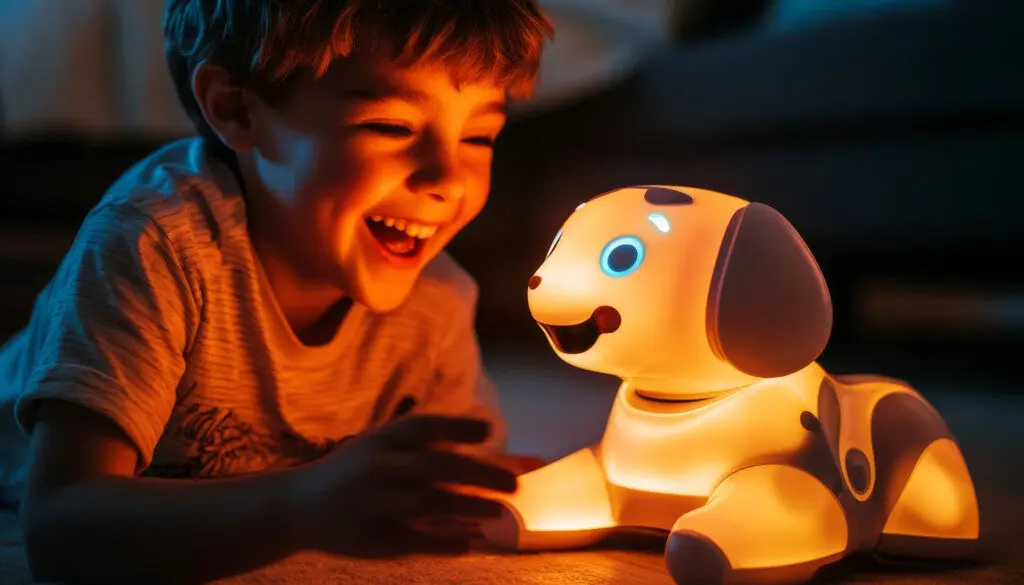Watching your child’s growth is a special experience for parents. You might wonder if your little one is growing as expected. The CDC says it’s key to track developmental milestones to see how a child is doing and spot any delays early.

By keeping an eye on these milestones, you can understand how your toddler is doing. This helps you pick activities that support their growth. It’s also important for spotting any issues early and creating a supportive environment for your child to grow.
Key Takeaways
- Understand the importance of tracking developmental milestones for your toddler’s growth.
- Learn simple and effective developmental activities to support your child’s progress.
- Discover how to identify any developmental delays early on.
- Create a nurturing environment that encourages your toddler’s development.
- Gain practical tips on monitoring your toddler’s milestones.
Understanding Toddler Development: The Importance of Milestone Tracking
Tracking your toddler’s growth can be very rewarding. It helps you see how they are doing. It’s key to support their development and help them reach their best.
Key Developmental Areas to Monitor
The Centers for Disease Control and Prevention (CDC) says it’s important to watch a few key areas. These include social skills, language, thinking, and physical movement. Here are the main ones:
- Physical skills like walking and using their hands
- Thinking and problem-solving abilities
- Language and communication, like talking and listening
- Social and emotional skills, like feeling and interacting with others
Why Regular Milestone Tracking Matters
Tracking your toddler’s milestones regularly is very important. It lets you see what they’re good at and what they need help with. This way, you can help them early if they’re falling behind. You can work with doctors to make a plan that fits their needs.
Setting Realistic Expectations for Your Toddler
It’s important to have realistic expectations for your toddler’s growth. Every child grows at their own speed. Comparing them to others can be unfair. Knowing what’s normal and watching your child’s progress helps create a supportive environment for them.
Physical Development: Activities to Build Motor Skills
Playtime is more than fun for your toddler. It’s key for their physical growth, boosting motor skills. Doing simple toddler developmental activities helps them do daily tasks better and interact with their world.
Fine Motor Skill Activities
Fine motor skills are vital for tasks needing precision, like picking up small things, drawing, and dressing. Here are activities to help improve these skills:
- Stacking blocks or cups to improve hand-eye coordination and dexterity.
- Playing with playdough to strengthen fingers and boost creativity.
- Picking up small toys or objects to practice precision and control.
- Using utensils like spoons or forks during mealtime to develop coordination.
Gross Motor Skill Activities
Gross motor skills involve bigger muscles and are key for movement, balance, and coordination. Encourage your toddler to do these toddler development activities:
- Running around in a safe, open area to improve cardiovascular health and coordination.
- Dancing to music to enhance rhythm and balance.
- Kicking a ball back and forth to develop leg strength and coordination.
- Climbing on playground equipment to build strength and confidence.
Tracking Physical Milestones Through Play
It’s important to watch your toddler’s physical milestones to make sure they’re growing well. Here are some toddler milestone tracking tips:
- Observe their ability to perform tasks like dressing and using utensils.
- Note their proficiency in gross motor skills, such as running, jumping, and climbing.
- Encourage activities that challenge their current skill level, promoting further development.
- Keep a journal or log to track progress over time, celebrating achievements along the way.
By adding these activities to your daily routine, you support your toddler’s physical growth. This lays a strong foundation for their future. Remember, every child grows at their own pace. Be patient and enjoy watching your toddler grow and thrive.
Cognitive Development: Brain-Boosting Play Ideas
As a parent, you play a big role in your toddler’s brain growth. This growth is about how they see, think, and understand the world. Playing activities that challenge problem-solving, memory, and focus can really help your toddler’s brain.
Problem-Solving Activities
Problem-solving is key for your toddler’s brain. Simple games like puzzles, shape sorters, or stacking toys can help them think and solve problems better.
- Puzzles: Start with simple puzzles to help with spatial awareness and problem-solving.
- Stacking Toys: Wooden blocks or plastic cups teach balance and gravity.
- Hide-and-Seek: This game helps your toddler understand where things are and how they relate to space.
Memory and Attention Activities
Boosting memory and focus is vital for your toddler’s brain. Fun and educational activities can help with this.
Some great activities include:
| Activity | Description | Benefits |
|---|---|---|
| Memory Games | Hide objects and ask your toddler to recall their location. | Improves short-term memory and concentration. |
| Story Time | Read stories together and ask questions about the narrative. | Improves attention span and comprehension. |
| Sorting Games | Sort objects by shape, color, or size. | Develops categorization skills and attention to detail. |
Cognitive Milestone Markers to Observe
Watching your toddler’s brain growth is important. Look for milestones like:
- Pointing to body parts when asked.
- Following simple directions.
- Imitating actions or activities.
- Demonstrating an understanding of cause-and-effect relationships.
By playing these brain-boosting games and watching your toddler, you help their brain grow. This ensures they reach their highest abilities.
Language Development: Communication-Enhancing Activities
Helping your toddler grow their language skills is a fun journey. It starts with everyday talks. As a parent, you’re your child’s first teacher. Nurturing their language is key to their growth.
Simple yet effective activities can boost your toddler’s communication. This is important for their development.
Vocabulary Building Games
Building your toddler’s vocabulary is fun. Here are some simple toddler developmental activities to try:
- Reading books together: Pick books with colorful pictures and fun stories.
- Singing songs and nursery rhymes: Music helps introduce new words and rhythms.
- Labeling objects: Point out and name things around the house or on outings.
These toddler development activities not only grow vocabulary. They also strengthen your bond.

Conversation and Expression Activities
It’s important to encourage your toddler to speak up. Talk to them by asking open-ended questions. Listen to what they say. Some simple toddler developmental activities include:
- Having mealtime conversations: Talk about daily events and their interests.
- Storytelling: Ask your toddler to share stories about their day or favorite things.
- Role-playing: Use play to act out scenarios, helping them communicate and express.
Language Milestones to Listen For
Tracking your toddler’s language growth is key. Here are milestones to watch for, part of milestones tracking for toddlers:
| Age | Language Milestones |
|---|---|
| 18 months | Says a few words to communicate, understands simple instructions |
| 24 months | Uses around 50 words, starts combining two words |
| 30 months | Uses around 100 words, starts using simple sentences |
By doing these activities and knowing the language milestones, you support your toddler. They will become confident communicators.
Social and Emotional Development: Building Relationship Skills
Helping your toddler grow their social and emotional skills is key. They learn to understand their feelings, show empathy, and make friends. This is a big part of their development.
It’s important to find activities that help your child with these skills. This way, they’ll grow into a confident and caring person.
Activities for Emotional Recognition
Teaching your toddler about emotions is very important. You can do this by:
- Labeling and validating their emotions
- Reading stories that depict different emotions
- Encouraging them to express their feelings through art or play
For example, you can make a “feelings chart” with faces. Ask your toddler to show how they feel. This helps them learn about emotions and how to talk about them.
“Emotional intelligence is the ability to recognize and understand emotions in oneself and others, and to use this awareness to guide thought and behavior.”
Social Interaction Activities
It’s important for your toddler to interact with others. You can help by:
- Arranging playdates with friends and family
- Engaging in role-playing activities, such as sharing toys or taking turns
- Participating in group activities, like singing songs or playing games
These activities help your toddler learn important social skills. They learn to work together, communicate, and solve problems.
Social-Emotional Milestone Checkpoints
As your toddler grows, keep an eye on their social-emotional milestones. Look for things like:
- Showing empathy towards others
- Cooperating with others during play
- Expressing a range of emotions
Tracking these milestones helps you see where your toddler might need extra help. This way, you can support them better.
By doing these activities and watching for milestones, you’re helping your toddler develop important skills. These skills will help them throughout their life.
Track Your Toddler’s Milestones with These Simple Developmental Activities: A Monthly Guide
Are you wondering if your toddler is developing as they should? Milestone tracking can help. The Centers for Disease Control and Prevention (CDC) offers checklists for different ages. A monthly guide helps you support their growth.
18-24 Month Milestone Activities
At 18-24 months, your toddler is exploring and becoming more independent. Here are activities for physical growth:
- Stacking cups or blocks
- Playing with playdough
- Walking along a straight line
For brain development, try these:
- Playing hide-and-seek
- Reading books together
- Singing simple songs
| Age | Physical Milestones | Cognitive Milestones |
|---|---|---|
| 18 Months | Points to body parts when asked | Imitates actions |
| 20 Months | Kicks a ball forward | Points to pictures in a book |
| 22 Months | Climbs up onto furniture | Follows simple directions |
| 24 Months | Kicks a ball forward with more force | Uses around 50 words |
24-30 Month Milestone Activities
As your toddler grows, they become more skilled and curious. For physical growth, try:
- Dressing and undressing themselves
- Using utensils to feed themselves
- Pedaling a tricycle
For brain development, engage in:
- Sorting objects by shape and color
- Playing matching games
- Completing simple puzzles
30-36 Month Milestone Activities
At 30-36 months, your toddler is more confident and independent. For physical growth, try:
- Throwing a ball overhead
- Balancing on one foot
- Using scissors to cut paper
For brain development, try:
- Engaging in role-playing
- Creating simple art projects
- Following more complex directions
By following this guide and engaging in these activities, you can track your toddler’s milestones and support their growth.
Creating a Milestone Tracking System That Works for Your Family
You can make a milestone tracking system that suits your family’s life. It’s key to have a system that helps you keep track of your toddler’s growth.
Digital Tracking Tools and Apps
Digital tools make tracking milestones easy and handy. The CDC’s Milestone Tracker app is great for this. It lets you check your toddler’s milestones and get tips on activities to help them grow.
Using digital tools has many benefits:
- Easy access to your toddler’s milestone data
- Reminders for upcoming milestones
- Personalized recommendations for developmental activities
| Digital Tool | Features | User Rating |
|---|---|---|
| CDC Milestone Tracker | Milestone tracking, reminders, activity tips | 4.5/5 |
| Chalkable | Milestone tracking, photo/video sharing | 4.2/5 |
| Canva | Customizable milestone charts, visual tracking | 4.8/5 |
Physical Journals and Visual Charts
If you like a more old-school way, use physical journals and charts. You can keep a special journal for your toddler’s milestones. Write down their achievements and how they’re doing.
Benefits of physical tracking methods include:
- Tactile experience of writing down milestones
- Visual representation of progress
- No dependency on technology
Photo and Video Documentation Methods
Photos and videos are great for capturing your toddler’s milestones. You can make albums or digital folders to keep these memories. This way, you can see how they’ve grown over time.
Here are some tips for documenting milestones with photos and videos:
- Take regular photos and videos of your toddler’s activities
- Create a dedicated album or folder for milestone documentation
- Include captions or notes to describe the milestone
Involving Caregivers and Family Members
Getting everyone involved in tracking milestones gives a fuller picture of your toddler’s development. Share digital tools or journals with caregivers and family. This way, everyone is on the same page.
Working together helps in many ways:
- Ensures consistent tracking of milestones
- Brings different views on your toddler’s development
- Helps make better decisions about their care and support
When to Consult Professionals: Understanding Developmental Concerns
Tracking your toddler’s milestones is very empowering. But, knowing when to seek professional help is just as important. As a parent, you’re best at spotting any big changes from what’s normal.
Common Red Flags to Watch For
Knowing the common red flags helps you spot issues early. Some signs that might mean your child needs a check-up include:
- Not responding to their name or other sounds
- Not making eye contact or having trouble with social interactions
- Not babbling or trying to talk by 12 months
- Not walking or having big delays in moving around
- Showing signs of losing skills they already had
If you see any of these signs, talk to your child’s doctor right away. Using a toddler developmental stages tracker can help you keep an eye on these milestones and spot any problems.

Resources for Developmental Screenings
The CDC and other health groups offer great resources for screenings. These screenings help find developmental delays early. You can:
- Talk to your pediatrician about screenings
- Use online tools like the CDC’s Developmental Milestones Tracker
- Go to regular check-ups to see how your child is doing
Doing activities to track toddler milestones and using these resources gives a full picture of your child’s growth.
| Age | Developmental Milestones | Red Flags |
|---|---|---|
| 12 months | Babbling, standing with support | No babbling, not standing with support |
| 18 months | Walking on their own, saying a few words | Not walking, no words |
| 24 months | Talking in short sentences, kicking a ball | Not talking in sentences, big delays in moving |
Working with Early Intervention Services
If your child is found to have delays, early intervention is key. This can include speech, occupational, and physical therapy. To get the most from these services:
- Follow the team’s advice
- Do the activities and exercises they suggest
- Talk often with the providers about your child’s progress
Communicating Effectively with Healthcare Providers
Being ready to talk about your concerns with healthcare providers is important. Keep a record of your child’s milestones with a toddler developmental stages tracker. Then, during the meeting:
- Share what you’ve noticed and are worried about
- Ask questions about your child’s growth
- Talk about things you can do at home to help
By being proactive and informed, you can work well with healthcare providers to help your child grow.
Conclusion: Celebrating Your Toddler’s Unique Developmental Journey
Remember, every child grows at their own pace. It’s important to celebrate the small wins. By doing toddler development activities and tracking milestones, you’re setting them up for success.
Tracking your toddler’s growth can be fun and rewarding. Stay patient and supportive. Every step, like learning a new word or skill, is a big deal.
Milestones tracking is more than just progress. It’s about creating a supportive environment for growth. This way, you’re not just tracking progress but also making lasting memories. Keep enjoying these moments and seek help when you need it.






